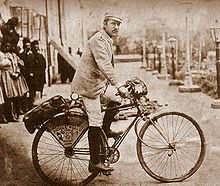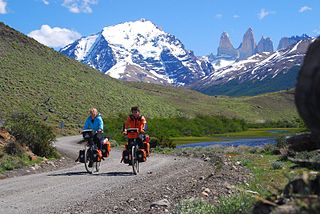
Bicycle touring is the taking of self-contained cycling trips for pleasure, adventure or autonomy rather than sport, commuting or exercise. Bicycle touring can range from single-day trips to extended travels spanning weeks or months. Tours may be planned by the participant or organized by a tourism business, local club or organization, or a charity as a fund-raising venture.

Bike lanes (US) or cycle lanes (UK) are types of bikeways (cycleways) with lanes on the roadway for cyclists only. In the United Kingdom, an on-road cycle-lane can be firmly restricted to cycles or advisory. In the United States, a designated bicycle lane or class II bikeway (Caltrans) is always marked by a solid white stripe on the pavement and is for 'preferential use' by bicyclists. There is also a class III bicycle route, which has roadside signs suggesting a route for cyclists, and urging sharing the road. A class IV separated bike way (Caltrans) is a bike lane that is physically separate from motor traffic and restricted to bicyclists only.

John Forester was an English-American industrial engineer, specializing in bicycle transportation engineering. A cycling activist, he was known as "the father of vehicular cycling", for creating the Effective Cycling program of bicycle training along with its associated book of the same title, and for coining the phrase "the vehicular cycling principle" – "Cyclists fare best when they act and are treated as drivers of vehicles". His published works also included Bicycle Transportation: A Handbook for Cycling Transportation Engineers.
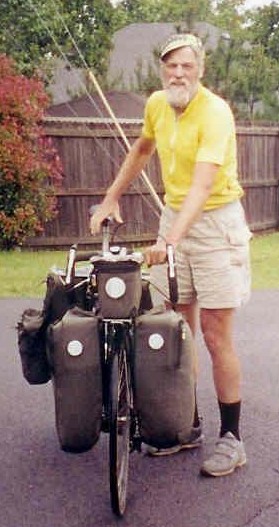
Ken Kifer was an American writer, bicyclist and webmaster. Kifer was a Walden scholar and admirer of Henry David Thoreau, and wrote Analysis and Notes on Walden. His website is still a source of information on bicycling and especially bicycle touring.

Vehicular cycling is the practice of riding bicycles on roads in a manner that is in accordance with the principles for driving in traffic. The phrase vehicular cycling was coined by John Forester in the 1970s. In his book Effective Cycling, Forester contends that "Cyclists fare best when they act and are treated as drivers of vehicles".

A bicycle boulevard, sometimes referred to as a neighborhood greenway, neighborway, neighborhood bikeway or neighborhood byway is a type of bikeway composed of a low-speed street which has been "optimized" for bicycle traffic. Bicycle boulevards discourage cut-through motor-vehicle traffic but may allow local motor-vehicle traffic at low speeds. They are designed to give priority to bicyclists as through-going traffic. They are intended as a low-cost, politically popular way to create a connected network of streets with good bicyclist comfort and/or safety.

A ghost bike is a bicycle roadside memorial, placed where a cyclist has been killed or severely injured, usually by the driver of a motor vehicle.

Sheldon Brown was an American bicycle mechanic, technical expert and author. He contributed to print and online sources related to bicycling and bicycle mechanics, in particular the web site Sheldon Brown's Bicycle Technical Info. His knowledge of bicycles was described as "encyclopaedic" by The Times of London.
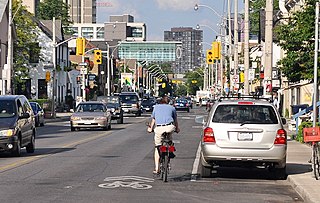
A shared lane marking, shared-lane marking, or sharrow is a street marking installed by various jurisdictions worldwide in an attempt to make cycling safer.
Cycling in Illinois encompasses recreation, bikeways, laws and rules, and advocacy. The director of the Illinois Department of Natural Resources, Joel Brunsvold, explained Illinois cycling opportunities: “Bicycle riding is one of the most popular outdoor recreational activities in Illinois, enjoyed by young and old alike...Illinois has a variety of trails for the public to enjoy. The terrain includes flat prairie land to rolling hills, towering bluffs to the breathtaking river and lakefront views.” Many communities across the state are updating bicycle infrastructure in order to accommodate the increased number of cyclists on the roads.

The following outline is provided as an overview of and topical guide to bicycles:

William Lewis Sachtleben was a 19th-century American journalist and lecturer who was one of the early globe-circling bicyclists, at one time holding a world record for long-distance bicycling.

David V. Herlihy is an author and historian. He is notable for writing Bicycle: The History, published by Yale University Press, and Lost Cyclist: The Epic Tale of an American Adventurer and His Mysterious Disappearance. He has also presented at the International Cycling History Conference and has published an opinion piece on cycling in The New York Times. He graduated from Harvard University in 1980 and is an alumnus of the Harvard Cycling Club. He is the son of noted historians David Herlihy and Patricia Herlihy.
Bicycling in Islam is a topic of discussion in Islam, primarily in regard to its use by Muslim women. Religious scholars are worried in particular about the effects of cycling on women's modesty and mobility.

Bicycle law is the parts of law that apply to the riding of bicycles.

The Idaho stop is the common name for laws that allow bicyclists to treat a stop sign as a yield sign, and a red light as a stop sign. It first became law in Idaho in 1982, but was not adopted elsewhere until Delaware adopted a limited stop-as-yield law, the "Delaware Yield", in 2017. Arkansas was the second US state to legalize both stop-as-yield and red-light-as-stop in April 2019. Studies in Delaware and Idaho have shown significant decreases in crashes at stop-controlled intersections. In France and Belgium, some intersections use red-light-as-yield signs.

The bicycle had a significant impact on the lives of women in a variety of areas. The greatest impact the bicycle had on the societal role of women occurred in the 1890s during the bicycle craze that swept American and European society. During this time, the primary achievement the bicycle gained for the women's movement was that it gave women a greater amount of social mobility. The feminist Annie Londonderry accomplished her around-the-globe bicycle trip as the first woman in this time. Due to the price and the various payment plans offered by American bicycle companies, the bicycle was affordable to the majority of people. However, the bicycle impacted upper and middle class white women the most. This transformed their role in society from remaining in the private or domestic sphere as caregivers, wives, and mothers to one of greater public appearance and involvement in the community. In the 21st century bicycling remains a contentious issue addressed by feminists in countries such as Saudi Arabia and Iran.

There is debate over the safety implications of cycling infrastructure. Recent studies generally affirm that segregated cycle tracks have a better safety record between intersections than cycling on major roads in traffic. Furthermore, cycling infrastructure tends to lead to more people cycling. A higher modal share of people cycling is correlated with lower incidences of cyclist fatalities, leading to a "safety in numbers" effect though some contributors caution against this hypothesis. On the contrary, older studies tended to come to negative conclusions about mid-block cycle track safety.
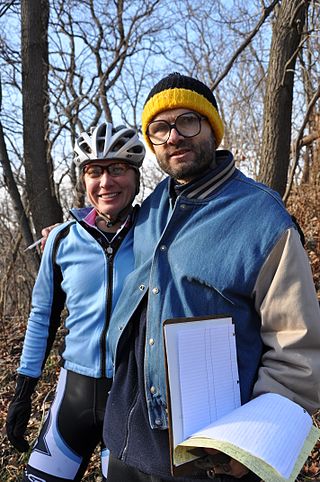
Daniel Paul Chew is an American former professional road racing and ultramarathon cyclist who twice won the Race Across America. He is also co-founder and promoter of the Dirty Dozen, an annual road bicycle race over Pittsburgh's thirteen steepest hills. Chew is a 2014 inductee into the UltraCycling Hall of Fame.
Lenz is a German surname.
